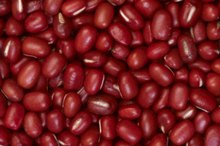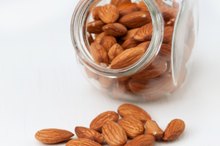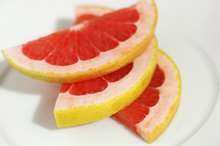What does fact checked mean?
At Healthfully, we strive to deliver objective content that is accurate and up-to-date. Our team periodically reviews articles in order to ensure content quality. The sources cited below consist of evidence from peer-reviewed journals, prominent medical organizations, academic associations, and government data.
The information contained on this site is for informational purposes only, and should not be used as a substitute for the advice of a professional health care provider. Please check with the appropriate physician regarding health questions and concerns. Although we strive to deliver accurate and up-to-date information, no guarantee to that effect is made.
Tuna and Acne
Approximately four in 10 teenagers suffer from acne or acne scarring, according to statistics from the American Academy of Dermatology website 1. Although acne is not a life-threatening condition, it can increase your risk of depression and anxiety. Nutrition is a double-edged sword when it comes to acne. Certain foods -- including tuna -- can help reduce acne symptoms while others can worsen acne.
Connection
Nutrition is an under-appreciated factor in acne development, reports nutrition scientist Loren Cordain, PhD, in an article published in the June 2005 "Seminars in Cutaneous Medicine and Surgery." In this review paper, Cordain notes that many people's diets -- rich in fast-digesting carbs, low in antioxidants and devoid of healthy fats -- play a crucial role in the biological causes of acne. Overproductive sweat glands, inflammation and clogged pores -- three factors in the development of acne -- can be reduced with certain modifications to one's diet. Tuna is one healthy food that may combat acne symptoms.
- Nutrition is an under-appreciated factor in acne development, reports nutrition scientist Loren Cordain, PhD, in an article published in the June 2005 "Seminars in Cutaneous Medicine and Surgery."
- Overproductive sweat glands, inflammation and clogged pores -- three factors in the development of acne -- can be reduced with certain modifications to one's diet.
Omega-3 Fats
Are Brown Rice and Sweet Potatoes Good for Acne?
Learn More
In the "Seminars in Cutaneous Medicine and Surgery" paper, Cordain notes that many people who follow Western diets don't get enough omega-3 fats. Omega-3 fats are anti-inflammatory fats found in plant foods, such as flaxseeds, and fish. Tuna is an especially abundant source of omega-3 fatty acids -- containing 1.5 grams of omega-3 fats per 170-gram serving -- according to the United States Department of Agriculture. A commentary published in the July 2003 "Archives of Dermatology" notes that an omega-3-rich diet may help combat acne in those who don't consume adequate omega-3 fats 1. Omega-3s combat inflammation on the skin -- a process that promotes sweat production and clogged pores.
- In the "Seminars in Cutaneous Medicine and Surgery" paper, Cordain notes that many people who follow Western diets don't get enough omega-3 fats.
- A commentary published in the July 2003 "Archives of Dermatology" notes that an omega-3-rich diet may help combat acne in those who don't consume adequate omega-3 fats 1.
Protein
A diet rich in protein and low in quick-digesting carbohydrates can significantly reduce acne, according to research published in the May 2007 "Journal of the American Academy of Dermatology." In this study of 43 men suffering from acne, it was discovered that a high-protein diet that also contained slow-digesting carbohydrates reduced acne symptoms by approximately 20 percent 1. A single can of white tuna contains 40 grams of protein, the United States Department of Agriculture states.
Considerations
Foods That Make Acne Flare Up
Learn More
While tuna contains two nutrients that may reduce acne symptoms -- omega-3 fats and dietary protein -- no study has singled out tuna as a treatment for acne. As with any chronic skin problem, talk to your doctor about treatment options. Tuna is high in mercury, an environmental toxin, so the U. S. Environmental Protection Agency recommends limiting tuna intake to two servings per week.
Related Articles
References
- American Academy of Dermatology: Acne Facts
- "Journal of the American Academy of Dermatology"; The Effect of a High-Protein, Low Glycemic-Load Diet Versus a Conventional, High Glycemic-Load Diet on Biochemical Parameters Associated with Acne Vulgaris: A Randomized, Investigator-Masked, Controlled Trial; R. Smith, et al.; May 2007
- EPA.gov: What You Need to Know About Mercury in Fish and Shellfish
- American Academy of Dermatology. Acne: Who gets and causes.
- American Academy of Dermatology. Adult acne.
- Zaenglein AL, Pathy AL, Schlosser BJ, Alikhan A, Baldwin HE, Berson, DS, et al. Guidelines of care for the management of acne vulgaris. J Am Acad Dermatol. 2016;74(5):945-73.e33. doi:10.1016/j.jaad.2015.12.037
- Ju Q, Tao T, Hu T, Karadağ AS, Al-khuzaei S, Chen W. Sex hormones and acne. Clin Dermatol. 2017;35(2):130-137. doi:10.1016/j.clindermatol.2016.10.004
- Dréno B. What is new in the pathophysiology of acne, an overview. J Eur Acad Dermatol Venereol. 2017;31 Suppl 5:8-12. doi:10.1111/jdv.14374
- Juhl CR, Bergholdt HKM, Miller IM, Jemec GBE, Kanters JK, Ellervik C. Dairy intake and acne vulgaris: A systematic review and meta-analysis of 78,529 children, adolescents, and young adults. Nutrients. 2018;10(8) doi: 10.3390/nu10081049
Writer Bio
Ryan Devon is a registered dietitian with a Master of Science in nutrition and health promotion from Simmons College. He starting writing in 2010, specializing in weight management and eating-disorder science.









